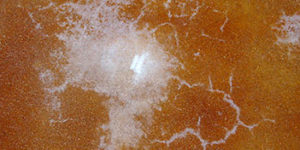 Decorative concrete craftsman and landscaper Randall Klassen cannot afford to let cold slow him down. He works in Winnipeg, Manitoba. Cold comes with the territory.
Decorative concrete craftsman and landscaper Randall Klassen cannot afford to let cold slow him down. He works in Winnipeg, Manitoba. Cold comes with the territory.
Still, we were a bit startled to get his latest batch of job pictures with the caption: “Pretty happy with this. We did the wood beams and vertical concrete. Nothing like killing it at minus 25!” Yes, minus 25 degrees.
A vertical concrete mix made adding Walttools’ Tru-Pac to mortar was used for the rockwork on the two-story home in Winnipeg. Klassen Concrete designed the front elevation, installed the Douglas fir 12-by-12 beams, and designed and installed the textured concrete patios and drive, plus xeriscaping.
“The project was done for a friend who is an outdoor enthusiast and loved the look of the chalets we saw while mountain biking in Whistler, British Columbia, this fall,” Klassen reports. “I designed his home around the things we saw there and how they could fit his lifestyle and our climate here in Winnipeg.”
How do you install vertical concrete in temperatures of minus 25? The same way all concrete guys do it. You build “hoarding” (housing around newly-poured sections) and you heat it up. “Once hot, we are working in T-shirts,” Klassen says. “It’s tougher to get a good perspective because you can’t step back and take a good look at things — so you don’t do real wild different things. It’s more work for sure, but at least we can still get some cool work done in the dead of winter!”
 |
 |
 |
We asked him: is there anything special you need to do when hoarding decorative concrete? “Good ventilation and not propane, because it tends to promote scaling.”
The interior contains architectural concrete too, Klassen reports: Mapei Ultraplan M20 self-leveling concrete went over wood subfloors (with the help of Top Chem and wire lath), and the stairs sport 1.25-inch ground concrete over wood stair (and riser) caps.
 |
 |
 |













